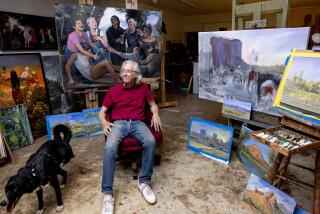Former South Africa mugger’s life took shape in prison
- Share via
Reporting from Soweto, South Africa — Sydney Cindi used to hang around banks, knife concealed, his concentration on the one thing he wanted: money.
“If you want a thing, you must concentrate on that thing. You want what you want. You concentrate on the money.”
When someone withdrew a fat wad of notes, he’d follow and mug him.
“Pointing a knife at someone, you must make him feel you are serious, but if he listens to what you are saying, his life is not in danger.”
That was in the late 1980s, before he was caught, served four years in prison and then, unlike many convicts, turned his life around. Now the onetime armed robber sits in the sun on Vilakasi Street, Soweto’s most famous tourist precinct, not far from Nelson Mandela’s old house, selling papier-mache sculptures to passersby.
Cindi, 47, fashions colorful township figures: women carrying bowls on their heads, kneading bread, sweeping or slapping their hymn books, singing in church — and men playing soccer, or guzzling bottles of rum with a foot in plaster from a drunken accident. He makes a lot of drunks.
Cindi learned to sculpt in jail. Few come out of South Africa’s thuggish, gang-dominated prisons as better men, he said. But he learned a lot about himself inside: how to like people a little more, how to live with himself, how to inspire others to follow him.
“That’s where I got my concentration from. That’s where I got my peace of mind.”
Cindi worked as a driver before being laid off when he was about 24 years old.
Jobless, he envied criminals.
“You’d listen to [the news] and you’d hear a place had been robbed. And you feel if it was you, you’d be happy.”
Cindi was an armed robber for several years before being caught. He saw money as a kind of medicine that could fix any problem. It’s not that he hated his victims. He just needed to terrify them, so he wore the fiercest face he could.
“When it comes to money, you don’t care if it’s a man or a woman. You don’t care who says what.”
When finally apprehended, he was sent to Groenpunt Prison, a world of gangs, theft and assault, conspiracies, fear and boredom. Steering clear of the gangs was the toughest part of being inside.
“On the outside, I had trained myself to look after myself, not to get involved in other people’s things. Everything I did with my own mind, not to be ruled by someone else. I never fell in with prison gangs.”
He noticed other prisoners collecting slivers of soap. Curious, he watched them mix the soap with paper and water to mold tiny figures. His own first model was a shoe because shoes were easy. He made a lot of shoes.
A lecturer from the nearby Vaal Triangle Technikon, a technical college now called the Vaal University of Technology, started a weekly clay sculpture class at the prison using clay donated by a nearby farm.
When Cindi sculpted, he felt as though he were no longer behind bars.
“When doing every piece [of sculpture] in prison, I never felt as if there were living people around me. I felt as if I was on my own planet.
“That’s when I started getting my concentration.”
Growing more ambitious, he and a fellow prisoner eventually sculpted a 4-foot-high gorilla. The two convicts were nominated as finalists in a national sculpture competition and allowed to attend the awards ceremony, shadowed by two guards.
“It made me very proud, because I wasn’t aware that I could become a well-known sculptor. I was in prison but my feeling was that they’ve locked me there in order for me to grow. That was the spirit driving me.”
To the authorities, he seemed a model prisoner. Yet he was secretly breaking the rules.
Persuading fellow prisoners to form a cooperative, he stored all their contraband — electric cables, a stove, food — under his bed. The exaggerated neatness of his bed — and his reputation as a model prisoner — made good cover. In return for the risk, prisoners shared the stove, light and food.
“I wanted us to share a good life. To keep the peace, I used to hide everything.”
If any prisoner tried to upset the system, Cindi and the others forced him to clean the cell toilets for a week as punishment.
Cindi had no sudden epiphany. He gradually changed from a man obsessed with getting money to someone who wanted to help people.
These days, when he sees a homeless orphan boy shivering in the street near his home, he takes the child in and tries to help. He worries that the boy might get ill from the cold, or be stabbed and killed by a mugger.
“Everything started in prison: being on my own, concentrating.”
When he was released, a few months before the nation’s first democratic elections in 1994, he was sponsored to study clay sculpture for a year. Then he worked in a school for disabled children. He left that job after seven years to focus on his own work.
When he left, he had about $5. He had no choice but to go back to the papier-mache creations he had learned to make in prison, but instead of soap he used “mealie meal” — corn porridge. It kept him full while also working as a stiff glue for his models. He collected paper from the streets to make the figurines.
Cindi perches his papier-mache sculptures on a wall along Vilakasi Street and waits for tourists.
He has run two rubbish cleanup days to train people to pick up litter. He also operates environmental awareness projects for schoolchildren, training them to collect garbage — they sell bottles and metal and use paper they find for sculpting. He’s expanding the project, training four unemployed young men to take over the art-from-rubbish projects in schools.
“My aim in life is to teach the entire community. I am not living a luxury life. But the life I’m living, I focus on the things I know and do best: my sculptures.”
More to Read
Sign up for Essential California
The most important California stories and recommendations in your inbox every morning.
You may occasionally receive promotional content from the Los Angeles Times.










